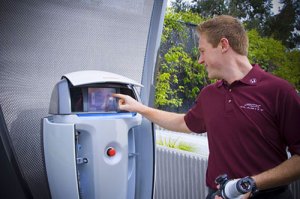 Enabling Grids for E-sciencE (EGEE) is the world’s largest multi-disciplinary computing grid, supporting the research of thousands of scientists and bringing together to the processing power of hundreds of thousands of computers worldwide. The grid and the software that glues it all together, known as middleware, is designed to run on a widely diverse range of computers. Now, a team from Ireland has adapted the grid software gLite to run on the Play Station 3. An Italian group has been able to use the iPhone to access grid enabled digital repositories.
Enabling Grids for E-sciencE (EGEE) is the world’s largest multi-disciplinary computing grid, supporting the research of thousands of scientists and bringing together to the processing power of hundreds of thousands of computers worldwide. The grid and the software that glues it all together, known as middleware, is designed to run on a widely diverse range of computers. Now, a team from Ireland has adapted the grid software gLite to run on the Play Station 3. An Italian group has been able to use the iPhone to access grid enabled digital repositories.
Since 2007 researchers from Trinity College Dublin (TCD) and the Royal College of Surgeons Ireland (RCSI) have been collaborating on the computing challenge inherent in drug discovery, and so when in the latter half of 2008 Symbiosis Ltd introduced a PS3 port of their eHITS drug discovery, the TCD team began in early 2009 to look into adapting, or porting EGEE’s grid middleware, gLite, to the PS3 platform. Since then their PS3 cluster has grown to 16 machines, which they can use to investigate the interactions between possible drug candidates and the diseases they are trying to treat. What makes this possible are the seven Synergistic Processing Elements (SPEs) that give the machine its computational power at relatively low cost. These elements are designed especially to support the complex 3D vector calculations that enable graphic intensive gaming — but also happen to be ideally suited to the team’s drug discovery work.
Eamonn Kenny who is on the TCD team was delighted with how well received the work has been by EGEE, “EGEE represents a major platform for European science, and its impetus toward multi-platform support is extremely helpful.”
While the EGEE computing grid is known for supplying huge amounts of processing power, it also provides a framework that allows databases and other information sources to be interlinked easily. Teams looking to create global digital repositories can use the grid to give access to their resources to research communities from all over the world. With both smart phones and high speed 3G networks moving rapidly into the mainstream a group of researchers from INFN Catania and University of Catania in Sicily saw an opportunity for an application to allow people access to digital repositories wherever and whenever they want.
Using gLibrary, which is based on the gLite middleware, an organisation can organise, populate, browse, search and access libraries of digital objects that have been stored on a distributed grid system. Accessing these resources from a user’s home machine is quite straightforward but more problematic if the researcher is travelling. This is where smartphones and multi-media devices such as the iPhone and the upcoming iPad show their strengths. Devices of this type are designed for accessing information while on the move but can also handle different types of data, such as videos, audio files, images, documents, spreadsheets and many more.
Using the Catania team’s application, a user can browse the digital libraries stored on the grid from their iPhone, query and inspect all the objects’ metadata and simply tap the screen to download a copy the from the closest storage element. They can choose the closest source either by selecting a location from a list or by using the built-in GPS to calculate their current position. During the event, the browsing of digital repositories of ancient manuscripts (cultural heritage) and satellite data (earth science) created with gLibrary will be demonstrated.
Both of these projects use commercially available platforms to run or interface with EGEE’s software. This demonstrates the flexibility and portability of EGEE’s software as well as one of the real world applications for distributed 24/7 access to the digital repositories made possible by EGEE.
The resources currently coordinated by EGEE will be managed through the European Grid Infrastructure (EGI) from May 2010. In EGI each country’s grid infrastructure will be run by National Grid Initiatives. The adoption of this model will enable the next leap forward in research infrastructures to support collaborative scientific discoveries. EGI will ensure abundant, high-quality computing support for the European and global research community for many years to come.
Learn more at http://www.eu-egee.org/


